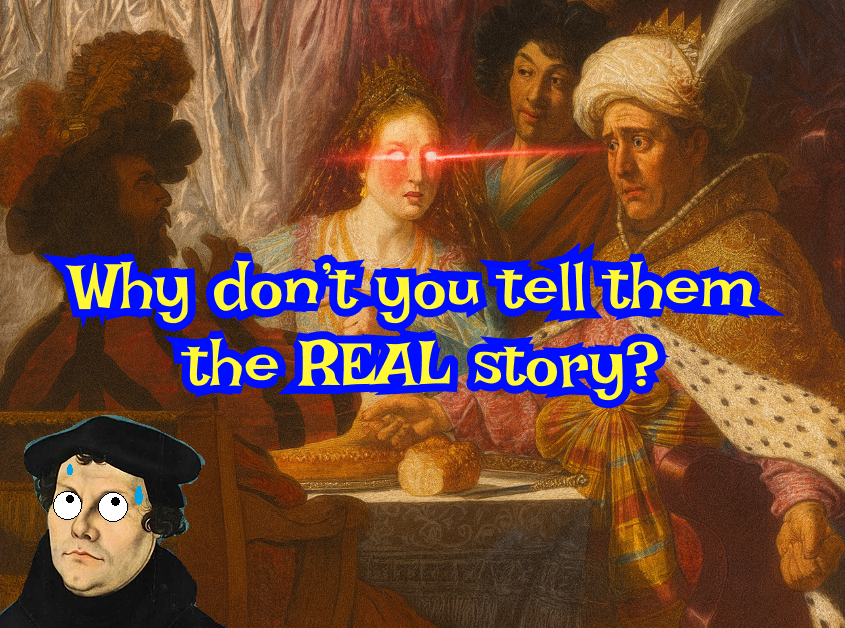
The Book That Forgot God: Esther, the Missing Verses, and the Bible of the Apostles
A quiet mystery inside your Bible
Open the Book of Esther in most Protestant editions and you will find vivid court drama, courage under pressure, and a reversal that saves a people. You will also find a profound silence. God is not named. There are no prayers. The text never once speaks His name. Among the books of Scripture in the Protestant canon, Esther is the only one with this feature.
The earliest Christians did not read Esther this way. In their Bible, the Greek Septuagint, Esther breathes with prayer and confession. Mordecai cries to the Lord. Esther fasts and pleads for mercy. The king’s edicts and the narrative frame acknowledge providence. The same story reads differently because the base text is different.
Two textual streams that shaped one story
The Old Testament you pick up today has been transmitted through two major streams. The first is the Greek Septuagint, a translation prepared by and for Greek-speaking Jews between the third and first centuries before Christ. This is the version most often quoted in the New Testament and the one that circulated in the early Church. The second is the Masoretic Text, a careful Hebrew recension preserved by Jewish scholars between the seventh and tenth centuries after Christ. The Masoretes added vowel points, accents, and notes and they ensured a standard Hebrew tradition after the birth and spread of Christianity.
When you compare Esther across these streams, the difference is striking. The Septuagint includes six sections that are not in the Masoretic version. These additions include Mordecai’s dream, edicts contextualized with appeals to justice, and, most importantly, prayers by Mordecai and Esther. The difference is not only a matter of length. It is a shift in tone and theology. In the Greek, God is confessed. In the later Hebrew recension used by Protestants, God’s action remains implied but unspoken.
What the Reformers chose and why that choice matters
The Reformers aimed for a return to the oldest attainable text. They judged the Hebrew manuscripts to be closest to the original and made a principled choice to privilege the Masoretic Text. Their intention was clarity and fidelity. The outcome, however, placed Protestants at some distance from the textual world of the apostles and the Fathers, who read and preached from the Greek Septuagint.
Martin Luther knew the Greek Scriptures and was not unaware of the later origin of the Masoretic recension or of the disputes over its editorial history. Yet, in spite of this and despite his own harsh polemics against the Jews of his time, he still preferred the Masoretic text as the foundation for his Old Testament translation. He regarded the Hebrew as more "authentic" even though it post-dated the Septuagint by nearly a millennium and had undergone deliberate adjustments in response to Christian interpretation. His decision fixed the pattern for later Protestant Bibles and effectively replaced the Bible of the apostles with a text produced long after the apostolic age.
In the case of Esther, that decision removed explicit prayers and references to God that the early Church received and used in worship. The story remains powerful in the shorter form, but the absence of these passages influences how readers perceive providence. The drama still turns. The reversals still come. Yet the script no longer shows the characters calling on the Lord by name.
The early Christian witness about the Scriptures
Early Christian teachers spoke with clarity about the Scriptures they received. They repeatedly cite the Greek Septuagint as authoritative. Augustine writes about the Spirit’s providence in the Church’s reception of the Greek text. Irenaeus defends the apostolic use of the Greek Scriptures. These voices reflect a stable reality in the first centuries. The Church prayed the Psalms and read the Law and the Prophets from Greek manuscripts, and those manuscripts included the longer Esther.
Some Fathers also claim that post-apostolic Jewish authorities disputed readings that the Church connected to Christ. Justin Martyr provides a notable example in his Dialogue with Trypho:
“I am far from putting reliance in your teachers, who refuse to admit that the interpretation made by the seventy elders is a correct one. They attempt to frame another. Know that they have altogether taken away many Scriptures from the Septuagint translation, which contain clear references to the sufferings and resurrection of Christ.”
Justin is not weighing minor vocabulary differences. He is alleging deliberate omissions of passages that the Church used to preach the Messiah. Whether one accepts every detail of his claim or not, his testimony shows how serious the early Christian community was about the Septuagint they had received, and how conscious they were of a growing divergence.
What exactly is “missing” in Esther
The Septuagint version of Esther contains six major additions, often labeled A through F in scholarly editions. These are not random expansions. They knit together the plot with prayers, prophecy, and acknowledgments of divine oversight.
- Addition A: Mordecai’s dream. He sees two dragons ready to fight, a small spring that becomes a river, and light that signals deliverance. The imagery anchors the historical crisis in a larger spiritual frame.
- Addition B: The king’s first edict against the Jews, cast as a formal decree with reasons and consequences. It reads like a court record and gives moral context to the injustice.
- Addition C: Mordecai’s prayer. He cries to the Lord of all, acknowledges sin, and begs for mercy on Israel.
- Addition D: Esther’s prayer. Before entering the throne room, she confesses her weakness, renounces the trappings of royal life, and asks God to turn the king’s heart.
- Addition E: The king’s counter edict for Jewish defense, with explicit recognition of the innocence of the accused.
- Addition F: The interpretation of Mordecai’s dream and a concluding notice of God’s deliverance.
Read as a whole, the Greek Esther is not a different plot. It is the same story seen in full light. The characters act, fast, and pray. God answers. Court politics remain part of the story, but they do not drive it. Providence does.
Why the difference changes how we read
A text that names God invites the reader to pray with the characters. It clarifies what is at stake. Mordecai does not rely only on strategy. Esther does not step into danger only by force of will. The people appeal to the Lord and are saved. In the shorter version, readers infer providence. In the longer, the confession is direct.
This is not an exercise in antiquarian curiosity. It concerns the scriptural diet of the Church. If the apostles and the earliest generations sang from and preached the Greek Esther, then recovering those prayers helps us hear what they heard. It places us closer to their Bible and their devotional life.
The Masoretic project in historical perspective
The Masoretes were disciplined scholars who guarded a Hebrew stream of the text. Their vowel pointing and marginal notes standardized readings and preserved a tradition that might otherwise have fractured. Their work came centuries after Pentecost and reflects a post-Temple, post-apostolic Jewish community that had already defined itself against Christian claims.
That historical setting does not invalidate their labors. It does explain why the Masoretic Text does not always align with the Scriptures the Church had already received and canonized through worship. When Protestants later privileged the Masoretic Text as the baseline for Old Testament translation, they tied themselves to a stream that is younger than the Septuagint and formed in a different religious context.
Justin Martyr and the charge of removal
Justin’s critique is specific. He asserts that teachers within the Jewish community “took away” readings in the Septuagint that Christians used to preach Christ. He names passages he believes were altered or excluded. His goal is not to score points. He is trying to persuade his Jewish interlocutor that the Church is not distorting the Law and the Prophets. He contends that the Church is reading them as they stood in the Scriptures received by the diaspora and then by the apostles.
The charge matters for Esther because it frames how we think about canonical reception. If the Church’s worship and preaching were shaped by the Greek Esther, and if the Fathers defend that reception on theological grounds, then the burden of proof falls on anyone who would remove those prayers from the hands of Christians.
Praying Esther with the early Church
The Greek Esther preserves several luminous prayers. They are simple, direct, and weighty. They present the living God as King over kings and the Savior of His people. They also show Esther as a model of repentance and courage who knows her help comes from the Lord.
Selections from the Septuagint Esther
“O Lord, Lord, King Almighty, all things are under Your power, and there is none that can oppose You when You desire to save Israel.”
(Esther 13:9)
“You know all things. You know that I hate the glory of the lawless and that I abhor the bed of the uncircumcised and of any foreigner. You know my necessity. Give me eloquent speech before the lion, and turn his heart to hatred of him who fights against us.”
(Esther 14:13 to 14)
“Remember, O Lord. Make Yourself known in the time of affliction and give me courage, O King of the gods and Master of all dominion.”
(Esther 14:12)
“God worked signs and wonders and saved His people, and He has allotted them joy for their sorrow.”
(Summary sense from the concluding notices in the Greek text)
These passages are not ornament. They are the spiritual center that gives the narrative its confession. With them, the story is prayer. Without them, the story must be inferred into prayer by the reader.
So what should a modern reader do
First, read Esther in your current Bible and notice the shape of the story. Second, read the Greek additions. Compare the tone, the confessions, and the way fear and courage are described. Third, consider the testimony of the early Church about the Scriptures it received and used. This is not a choice between scholarship and devotion. It is a choice to let the devotional life of the first Christians inform your reading today.
Conclusion
The Book of Esther in the Protestant canon presents deliverance in a whisper. The same book in the Septuagint presents deliverance in prayer. The early Church read the latter. The Reformers, for reasons they judged sound, chose the former. If you want to stand closer to the world of the apostles, read the prayers that they knew. Hear Mordecai call to the Lord. Walk with Esther as she sets aside royal garments, fasts, and asks for courage. Let the text speak with the voice that shaped the first centuries of Christian worship.
Read the Greek additions and the books Protestants removed
Explore the full Greek text of Esther and the other deuterocanonical books that remained in the Bibles of the early Church.
- Esther with Greek additions (Douay tradition with chapters 10 to 16 for the additions)
- Tobit
- Judith
- Wisdom of Solomon
- Sirach (Ecclesiasticus)
- Baruch with the Letter of Jeremiah
- First Maccabees
- Second Maccabees
- Daniel with additions including the Prayer of Azariah, the Song of the Three, Susanna, and Bel and the Dragon
